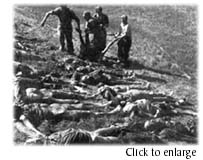
In its last months Flossenbuerg became a reception camp for thousands of prisoners from the evacuated concentration camps in the occupied lands to the east, as well as the eastern portions of Germany itself. In the now completely overfilled camp illness and epidemics spread even faster. The number of deaths climbed steeply.
On April 20, 1945 began the "evacuation" of the approximately 16,000 prisoners. 1200 prisonors who were no longer able to travel remained behind. Perhaps this was connected with the recent visit to the camp of Count Bernadotte with a column of 32 trucks from the International Red Cross.
A number of columns of prisoners, comprising several thousand men, marched through the middle of the village in the direction of Dachau and the last stronghold in the Alps. There were four guards for every 100 prisoners.
Physically exhausted men who were no longer able to go on where shot by the SS. Thousends of corpses linend the route. At the end of April, 1945, units of the Third US Army were finally able to free most of the surviving evacuees.
The Flossenbuerg camp itself was freed at 10:30 a.m. on April 23, 1945. Before their retreat the SS had burnt almost all the incriminating documents and instruments of death.
Between 1946 and 1948 the American military courts in Dachau brought charges against members of the SS and the capos of the camp at Flossenbuerg. 25 of these were sentenced to death; 17 death sentences were actually carried out, while the other 8 were commuted to life imprisonment. Until the middle of the 1960s about 200 legal processes were still underway.


